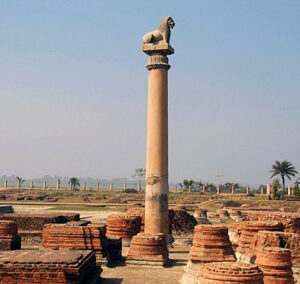
Vaishali was a city in Bihar, India, and is now an archaeological site. It is a part of the Tirhut Division.
Vaishali today is a small village surrounded by banana and mango groves as well as rice fields. But excavations in the area have brought to light an impressive historical past. The epic Ramayana tells the story of the heroic King Vishal who ruled here. Historians maintain that one of the world’s first democratic republics with an elected assembly of representatives flourished here in the 6th century B.C. in the time of the Vajjis and the Lichchavis. And while Pataliputra, capital of the Mauryas and the Guptas, held political sway over the Gangetic plain, Vaishali was the center for trade and industry.
Numerous references to Vaishali are found in texts pertaining to both Jainism and Buddhism, which have preserved much information on Vaishali and the other mahajanapadas.
Lord Buddha visited Vaishali frequently and at Kolhua, close by, preached his last sermon. To commemorate the event, Emperor Ashoka, in the third century B.C. erected one of his famous lion pillars here. A hundred years after the Mahaparinirvana of the Buddha – Vaishali hosted the second great Buddhist council. Two stupas were erected to commemorate this event.
Jainism, too, has its origins in Vaishali, for in 527 B.C., Lord Mahavir was born on the outskirts of the city, and lived in Vaishali till he was 22. Vaishali is then twice blessed and remains an important pilgrim center for both Buddhists and Jains, attracting also historians foraging for the past.
On the outskirts of Vaishali stood the grand double storied Buddhist monastery, where Buddha often discoursed. He extended spiritual enfranchisement to women by admitting them to the Holy Order which was founded here. Legend has it that on one of his visits, several monkeys dug up a tank for his comfortable stay and offered him a bowl of honey. This is regarded as one of the great incidents in the legends of Buddha, who announced his approaching Nirvana and preached his last sermon here.
Relic stupa
Near the coronation tank is Stupa 1 or the Relic Stupa. Here the Lichchhavis reverentially encased one of the eight portions of the Master’s relics, which they received after the Mahaparinirvana. After his last discourse the Awakened One set out for Kushinagar, but the Lichchhavis kept following him. Buddha gave them his alms bowl but they still refused to return. The Master created an illusion of a river in spate which compelled them to go back. This site can be identified with Deora in modern Kesariya village, where Ashoka later built a stupa.
Kutagarasala Vihara
Kutagarasala Vihara is the monastery where Buddha most frequently stayed while visiting Vaisali. It is located 3 kilometres from the relic Stupa, and on its ground can be found the Ānanda Stupa, with an Asokan pillar in very good condition (perhaps the only complete Asokan pillar left standing), and an ancient pond.
Coronation Tank
A few hundred metres from the Relic Stupa is Abhishek Pushkarini, the coronation tank. The sacred waters of the tank anointed the elected representatives of Vaisali
World Peace Pagoda:Next to the coronation tank stands the Japanese temple and the Viśvā Śānti Stūpa (World Peace Pagoda) built by Japanese Nichiren Buddhist sect Nipponzan-Myōhōji. A small part of the Buddha’s relics found in Vaiśālī have been enshrined in the foundation and in the chhatra of the Stupa.
Vaishali mahotsava is held to celebrate the birth anniversary of the Jain Tirthankar, Lord Mahavir on the full moon day of the month of “Vaisakh” (mid-April).
Source:
https://en.wikipedia.org/wiki/Vaishali_(ancient_city)
http://bstdc.bih.nic.in/vaishali.htm
http://scrapboktravelblog.blogspot.in/2016/01/vaishali-relic-stupa-and-asoka-pillar.html


